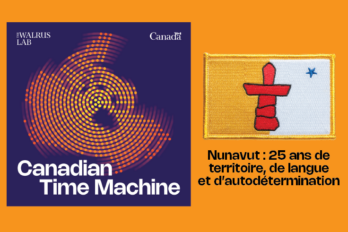SHOW NOTES:
SOURCES USED IN THIS EPISODE
The music for this episode is a licensed version of “This Podcast Theme” by InPlus Music. Additional music are licensed versions of “Stay Cool” by Loops Lab, and “Podcast Intro” by InPlus Music.
LINKS MENTIONED IN THIS EPISODE:
- Feeling the Burn: The Workout Video from Jane Fonda to Peloton
- Links to stories about Black History Month
ADDITIONAL LINKS:
TRANSCRIPT:
SHEENA ROSSITER: Welcome to the deep dive from The Walrus, a weekly podcast that takes a deeper look into the happenings at The Walrus I’m Sheena Rossiter.
ANGELA MISRI: And I’m Angela Misri. On this week’s episode:
CARINE ABOUSEIF: The evolution of workout videos from the Jack LaLanne era to the videotapes was an important one because people now had the ability to workout whenever they wanted.
ANGELA MISRI: We’ll hear from Carine Abouseif, a features editor at The Walrus. Before joining The Walrus, she edited news and features at the Globe and Mail, and her writing has appeared in the Globe, Maisonneuve, and This Magazine.
And she’s going to tell us all about her latest feature, which looks at the rise of the home workout video.
SHEENA ROSSITER: Now, I have to say, I have gotten on that bandwagon in the past several months. Because it’s been so cold, I haven’t been able to go on my usual COVID walks, and with omicron, I don’t want to go back to the gym. So I’ve turned to YouTube workout videos. Is that what Carine has found?
ANGELA MISRI: So, when you write a story like this it’s usually because you’ve developed a bit of an interest in the subject, and that was the case for Carine. Like you, the pandemic disrupted her “normal” workout routine and she went down a bit of a rabbit hole looking for at-home solutions. I’m going to let her tell you about it though – here’s Carine Abouseif.
ANGELA MISRI: So why did you want to write about home workout videos?
CARINE ABOUSEIF: Pre-pandemic, exercise, or just moving my body, I think was something I was very unintentional about. I walked almost everywhere and when I participated in more formal exercise, I was sort of drawn to the in-person class setting, even though I’m actually not the most social person. It might be because I’m lazy and I need that setting to make sure someone’s watching me finish my set or whatever, but I suspect I’m not alone in that. And so fast forward to the pandemic, I was lucky enough to be working from home. But what that meant is I suddenly had to be more intentional about moving my body and I had to do it on my own. And so I found myself kind of digging up old workout tapes and videos, things that my mom had owned back in the nineties and returning to the kind of fitness influencers of today who post workout routines on YouTube. And I noticed this boom, not just in nostalgia for like Jane Fonda workouts, but also in subscriptions for the influencers of the day. And then I wanted to explore that a bit.
ANGELA MISRI: You got into the research phase, you started to find out when the TV workout got popular. Can you tell us a little bit more about that, that beginning of that era when TV workouts became super popular?
CARINE ABOUSEIF: So one of the great things about writing a piece like this was getting to chat with a historian who focuses on fitness. Natalia Mehlman Petrzela, who has a forthcoming book called Fit Nation. And one of the things she told me about was that one of the first people to do guided exercise on television is Jack LaLanne.
AUDIO CLIP (JACK LALANNE): Good Morning! Happy Monday morning to you. Thanks very, very much for letting me come into your home. You know, my name is Jack LaLanne and I’m here for one reason. And one reason only to show you how to feel better and look better. So you can live longer. Please keep your dial right where it is because I want to become real good friends with you.
CARINE ABOUSEIF: And his show kind of came on in the 1950s as television ownership across North America, kind of became the norm, and this kind of really targeted homemakers who spent a lot of time at home, not unlike ourselves.
ANGELA MISRI: What’s interesting is that if you think about the stereotypical homemaker, and I’m putting homemaker in quotes, was that person was usually female. So why did Jack LaLanne appeal to them? Why was he the pioneer of these types of workouts?
CARINE ABOUSEIF: I don’t really actually know the reason why it was him specifically, but one of the things he did was thank viewers for allowing him into their home. He really sold this idea that women should sort of put down their chores, put down their ironing and take 15 minutes to themselves. This idea was a, a really winning idea for the time. I think we could probably do a whole separate article and, and podcast about the evolution of just how fitness gear has changed over the years. But I think through today’s lens and also through the language that LaLanne used around, like trimmer busts and smaller waists, it’s really easy to see how something like this could also feel a little bit like work instead, something you do for yourself. And I think that resonates for a lot of people in the pandemic too. Like not only do I have to live in another pandemic day, I also have to exercise after that.
ANGELA MISRI: There’s some irony to what you’re talking about though. Some of his appeal seems to be the Mr. Rogers approachable thing, kind of a welcome to my healthy neighbourhood. Take a minute for yourself because you’re important, too. But at the same time, as you said, he talked about, you know, nicer busts and the ideal waistline, that’s an odd mix of making you feel empowered about your time, but also guilty about your looks.
CARINE ABOUSEIF: Absolutely.
ANGELA MISRI: Yeah. That’s interesting to me. So after that, and speaking of questionable workout clothes, this medium really evolved into the workout videos by people like Jane Fonda.
AUDIO CLIP (JANE FONDA): To achieve the sculpted physique of optimum fitness. You should combine these strength classes with aerobic training, which burns body fat and improves cardiovascular fitness.
ANGELA MISRI: And then who could forget Sweatin’ to the Oldies with the king of candy stripe shorts, Mr. Richard Simmons.
AUDIO CLIP (RICHARD SIMMONS): Hi everybody! Hey, tell me who wants to dance?!
ANGELA MISRI: And those videos were all a little kitchy and Fonda and Simmons especially were almost caricatures of themselves, but all of our mothers had those videos. So how has the at home workout evolved from that to now?
CARINE ABOUSEIF: The evolution of workout videos from the Jack LaLanne era to the videotapes was an important one because people now had the ability to workout whenever they wanted, which seems like sort of a given to us today. But for someone in the 1950s, you know, they had appointment viewing with Jack LaLanne. And, you know, along came Jane Fonda and the rest, and people could just workout whenever they had the time. And we still sort of have that today with YouTube where so many popular fitness influencers are, I’m thinking of people like Chloe Ting who has 22 million subscribers, for example.
AUDIO CLIP (CHOLE TING): Hey guys this is a quick five minute warm up routine that you can do before your daily workout. Warm ups are really important to reduce chances of injuries. So make sure you do them before your workouts. We’ve got 13 exercises, 20 to 30 seconds on get on your mat, kicking off with cat cow.
CARINE ABOUSEIF: This isn’t true across the board, but perhaps one of the things that make me kind of uncomfortable with the current climate around fitness is the sort of quote unquote chat mentality. So many of these influencers will post 21 day challenges, for example, where you follow a workout calendar and do different videos every day for 21 days or 30 days or whatever it is.
ANGELA MISRI: I think Jenn just posted about some 30 day yoga challenge on our office Slack. Didn’t she?
CARINE ABOUSEIF: Yes, she did. It’s the 30 days of yoga with Adriene. And that’s something that’s been going on for years. And I would say that Adriene in particular is someone whose workouts I enjoy because she often uses this phrase, find what feels good.
AUDIO CLIP (ADRIENE MISHLER): Also gives you the freedom to move, how you wanna move, find what feels good.
CARINE ABOUSEIF: Which sort of feels a little bit counter to some of the things I’m talking about here. Some of these 21 day challenges, they also have some kind of physical outcome associated. So do this for 21 days and you’ll have visible abs for example. And sometimes there’s kind of like a nutrition component. So that’s, I think what sometimes makes me feel a bit uncomfortable.
ANGELA MISRI: Well, at the end of the day, this is a business and this is an industry. So do you think home workouts are going to pick up and exceed the gym sign ups we usually see at this time of year, you know, for like new year’s resolutions, for example?
CARINE ABOUSEIF: The surveys on this have been actually kind of mixed, which is understandable given how up and down the pandemic has been. Some people say they’re never going back to the gym. Other people say they can’t wait and they’re lining up every time gyms reopen in their area. What seems to be consistent, though, is that a lot of people say, that even if they do go back, they will continue some aspect of working out from home. So they might do more of a hybrid thing. Kind of like how people are imagining office work might look like in the future. They might treat working out at a gym, more like a social event, for example. So I think that’s where sort of things are going shift a bit. I’ll caveat, all of, of what I’ve said by noting that obviously a lot of people love homework videos and have been doing them for years, even like before the pandemic. There’s a reason people like Blogilaties and Yoga with Adriene have had a following for so long. Their workouts are free, you can do them away from like the prying eyes at the gym. You can do them anytime you want. During the day. In some cases you, you can do them while watching your kids.
ANGELA MISRI: Let’s find out what Carine is listening to right now.
CARINE ABOUSEIF: I’m currently listening to another podcast called Maintenance Phase. If you somehow, haven’t heard of it. It’s hosted by Michael Hobbs and Aubrey Gordon. And they spend every episode, debunking wellness myths. They talk about Dr. Oz, celery juice, fitness influencers, all that kind of stuff. It’s a really fun listen.
ANGELA MISRI: That’s my conversation with Carine Abouseif. The handling editor for her story is Monika Warzecha. Go to thewalrus.ca to read more stories from our digital series on wellness. And keep an eye out for Carine’s article in the podcast’s show notes.
WHAT WE’RE TALKING ABOUT THIS WEEK AT THE WALRUS:
VILAYATH ALI: I’m Vilayath Ali, and here’s what we’ve been talking about this week at The Walrus.
Ottawa mayor Jim Watson declared a state of emergency for his city so we’re all still sharing the latest news about the trucker protest and checking in with friends, family, and our fellow journalists all over Ontario as the protest spreads.
Black History Month is always a great reason to surface and highlight content by Black contributors to The Walrus, so head to thewalrus.ca/blackhistory to catch up.
And Olympic fever (or at least Olympic interest) has taken hold of The Walrus slack channels, but so has Conservative Leadership speculation. We’re always looking for thoughtful takes on Canadian politics, so if you have a story idea, send it in to pitch@thewalrus.ca.
As always, the links for all these articles can be found in the show notes for this episode.
CREDITS:
SHEENA ROSSITER: Thanks for joining us on this week’s episode of the Deep Dive. It was produced by Angela Misri, and me, Sheena Rossiter. Shayne Giles edited this episode.
Thanks so much to Carine Abouseif for joining us this week.
Music for this podcast is provided by Audio Jungle. Our theme song is This Podcast Theme by Inplus Music. Additional music is Stay Cool by Loops Lab, and Podcast Intro by Inplus Music. You also heard Every Morning, provided by pixabay.
Additional audio comes from Chloe Ting, Top Cat, Jack LaLanne Official, Richard Simmons, and Yoga with Adrienne on YouTube.
Don’t forget to subscribe to Deep Dive from The Walrus on Apple Podcasts, Spotify, or wherever you get your podcasts. And if you like what you heard, please leave us a review and rating. It really helps people find the podcast.
Until next week when we take our next deep dive.









